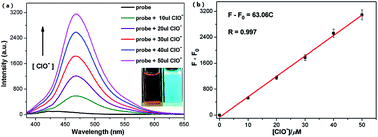An ICT based ultraselective and sensitive fluorescent probe for detection of HClO in living cells†
Abstract
An ICT based ultraselective and sensitive probe for colorimetric and fluorescent detection of HClO via oxidative cleavage of an alkene linker to epoxide and then to aldehydes was developed through the conjugation of pyridinium with vanilline.


 Please wait while we load your content...
Please wait while we load your content...